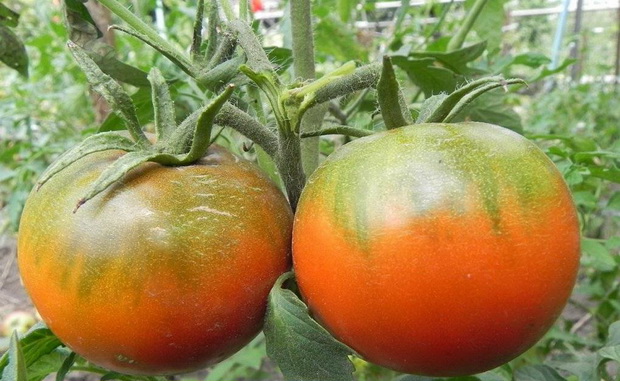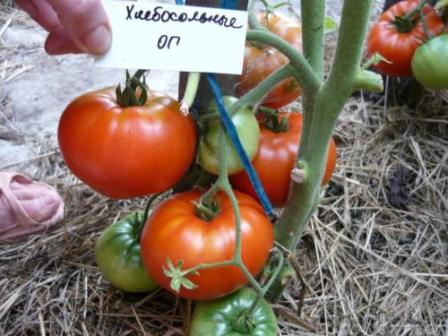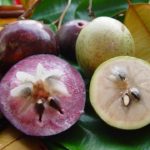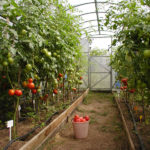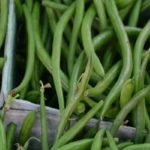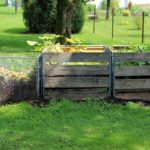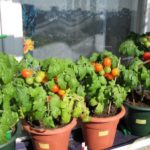How much love, joy, work and pride the Siberian breeders put into a simple phrase for their creation. Bread and salt have always been associated with a fruitful year and prosperity in the family, and the Khlebosolny tomato fits surprisingly harmoniously into this concept. A simple but very healthy lunch, breakfast or dinner immediately appears, especially if fresh, juicy fruits from a summer cottage or garden plot are used for preparation.
Features of the variety
Among the huge variety of varieties, the Khlebosolny tomato occupies a special place.This is a classic fruit that changes color from light green to bright red when ripe. The difficult climatic conditions of Siberia have made it possible to select tomatoes with particular resistance to weather changes. This allows you to grow fruits both in risky farming areas and in greenhouse conditions.
Several features of the classic representative of this variety can be identified:
- The height of the bush reaches approximately one meter.
- The fruits are large: adult tomatoes can weigh up to one kilogram.
- Sufficiently developed, branched, during the formation period it requires tying.
Difference from other varieties
Experienced gardeners immediately noted that this variety has the following properties:
- Increased resistance to short-term frosts or other unfavorable climatic conditions. The tomato will survive heavy rain and even small hail. Unripe tomatoes are especially dense and protected by a thick skin. The bush is powerful enough to withstand gusts of wind.
- Takes root well in open ground. It quickly adapts after transplantation and begins to form a bush and ovaries.
- It has an excellent defense system and resists various fungal diseases.
- During the period of bush formation, ripening and further development, the characteristics and descriptions of the Khlebosolny tomato variety usually indicate that the stems and leaves produce special substances that repel pests.
- It can fight weeds and partially suppress their activity. It has a developed root system.
- Due to the wide foliage, it can tolerate insufficient lighting.
How to Make the Most of the Above Benefits
The final result depends on proper care of the crop. Such a parameter as productivity increases, because this is where all efforts are directed.
How to achieve maximum results? There are a few tips to consider:
- Seed germination is done in advance. To do this, use a damp cloth. The seeds are located at a distance of 1-2 cm from each other.
- Now let's prepare the soil in the greenhouse. It should be well sifted and fertilized soil with a small admixture of sand. When the sprouts have formed, planting begins in previously prepared soil.
- After about two months, when the seedlings have formed, hardening can begin. We open the greenhouse for half an hour a day, gradually increasing the time.
- When the external temperature reaches 20 - 22 degrees, the Hospitable pink variety is ready for planting in previously prepared beds.
During the preparation stage, many amateurs try to protect the crop from exposure to adverse factors and use small cardboard cups for planting, which prevent the penetration of various parasites.
There are several options for forming beds:
- We make a groove about 10 - 15 cm deep, be sure to mix natural fertilizers with the soil, and plant the seedlings at a distance of 30 cm. Then, using a hoe, we loosen the soil at both ends and form a small mound along the entire length. In the reviews you can see something like the following: “I have planted this way for many years and have no complaints.” The distance between the beds - at least 50 cm - is necessary for good lighting of the bushes, watering and tillage.
- The second option is more labor-intensive, but there are good reviews on yield. We fertilize and loosen the soil. We make holes and place the seedlings, observing all the previously specified distances. We form grooves for further processing on the sides of the beds.
It is recommended to lay the still unformed root system in such a way that when watering there is a maximum irrigation area. Usually the roots are directed towards the watering grooves, and tying devices are dug in on the reverse side.
Be sure to water the seedlings after planting and try to keep the soil moist for a few days. Watering is carried out individually under the root of each plant.
After this, we loosen the soil and let the plant breathe for 24 hours.
This moment can be called a turning point in the life of the plant. Creative work begins on the formation of hospitable tomatoes (bush and number of ovaries). Usually three branches and five ovaries are left on each of them. Of course, everything depends on climatic factors and the quality of plant care. Ideally, at the end of the season there will be fully formed fruits weighing up to 1000 grams.
Many hobbyists set their goal to grow fruits of smaller weight and size. Tomatoes are very convenient for pickling and can be picked in advance. I like this method because:
- After removing some of the fruits, the plant is significantly “unloaded”, and the remaining tomatoes grow faster.
- The housewife has a certain amount of time to carry out conservation.
- Tomatoes have the unique property of ripening when kept in a warm, dark place: the fruits gradually turn red and become suitable not only for canning, but also for preparing various salads or dishes.
How to properly care for a plant
Here it is important to observe the frequency between watering, weeding, loosening and fertilizing the soil. Staying in wet soil for a long time harms the root system and promotes the development of soil bacteria that inhibit the culture.Tomatoes love abundant watering - in this case, the water penetrates deep into the soil and gives the plant the necessary moisture as it evaporates. During this time, the top layer of soil dries out, and the soil must be loosened, thereby ensuring air access to the root system.
It is best to use a combined fertilizer, for example, organic and mineral. Initial fertilizing can be done with manure and ash, then nitrogen, sodium and other types of fertilizers can be used. Everything is good in moderation: if the soil bears fruit well and the plant develops, three or four feedings per season are enough.

